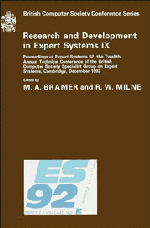Book contents
- Frontmatter
- Contents
- Preface
- Introduction
- CONSULTANT: providing advice for the machine learning toolbox
- A methods model for the integration of KBS and conventional information technology
- KBS methodology as a framework for co-operative working
- Project management for the evolutionary development of expert systems
- The specification and development of rule-based expert systems
- Towards a method for multi-agent system design
- Jigsaw: configuring knowledge acquisition tools
- On the relationship between repertory grid and term subsumption knowledge structures: theory practice tools
- Strategy maze: an on-line tool for support management of the knowledge acquisition process
- Concurrent engineering using collaborating truth maintenance systems
- Ockham's razor as a gardening tool
- A designer's consultant
- Fairness of attribute selection in probabilistic induction
- An application of case-based expert system technology to dynamic job-shop scheduling
- Neural network design via LP
- KEshell2: an intelligent learning data base system
- Approaches to self-explanation and system visibility in the context of application tasks
- An object oriented approach to distributed problem solving
- Intelligent user interface for multiple application systems
- Combining qualitative and quantitative information for temporal reasoning
- Documents as expert systems
Concurrent engineering using collaborating truth maintenance systems
Published online by Cambridge University Press: 04 August 2010
- Frontmatter
- Contents
- Preface
- Introduction
- CONSULTANT: providing advice for the machine learning toolbox
- A methods model for the integration of KBS and conventional information technology
- KBS methodology as a framework for co-operative working
- Project management for the evolutionary development of expert systems
- The specification and development of rule-based expert systems
- Towards a method for multi-agent system design
- Jigsaw: configuring knowledge acquisition tools
- On the relationship between repertory grid and term subsumption knowledge structures: theory practice tools
- Strategy maze: an on-line tool for support management of the knowledge acquisition process
- Concurrent engineering using collaborating truth maintenance systems
- Ockham's razor as a gardening tool
- A designer's consultant
- Fairness of attribute selection in probabilistic induction
- An application of case-based expert system technology to dynamic job-shop scheduling
- Neural network design via LP
- KEshell2: an intelligent learning data base system
- Approaches to self-explanation and system visibility in the context of application tasks
- An object oriented approach to distributed problem solving
- Intelligent user interface for multiple application systems
- Combining qualitative and quantitative information for temporal reasoning
- Documents as expert systems
Summary
ABSTRACT
The truth maintained blackboard model of problem solving as used in the Loughborough University Manufacturing Planner had supported collaboration between experts which were closely linked to the management system. On realistic problems the size of the assumption bases produced by the system and the overall size of the blackboard combined to impair the performance of the system. This model of design supported the collaboration of experts around a central blackboard. Clearly collaboration is a necessary condition for concurrent decision making and so the basic framework for collaboration is preserved in this model.
The Design to Product management system within which the Planner had to operate had a central “Tool Manager” through which all communication was routed. In order to implement a model of simultaneous engineering and also to support collaborative work using this model a multiple context design system is useful, if not essential. Our model extends this by distributing the control between the various expert agents where each agent treats the others as knowledge sources to its own private blackboard. All interaction between agents is done using a common communication protocol which is capable of exchanging contextual information necessary to separate contexts in the Assumption based Truth Maintenance System (de Kleer 84) environment. The hierarchical model of control by a central tool manager has been replaced by a hierarchical model of distributed control. The agents are configured using a single line inheritance scheme which endows each agent with its required knowledge and also allows it to declare its functionality to its colleagues.
- Type
- Chapter
- Information
- Research and Development in Expert Systems IX , pp. 165 - 182Publisher: Cambridge University PressPrint publication year: 1993
- 1
- Cited by



